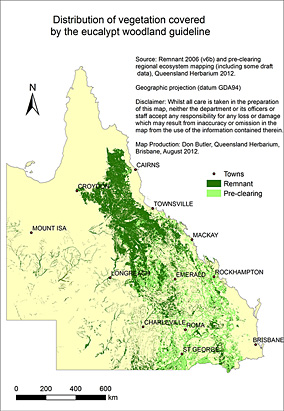Description


What are they?
Woodland is a vegetation type with widely spaced trees that let in plenty of light. The ground layer is more likely to be grassy than densely shrubby, which can give woodlands a ‘park-like’ appearance.
Woodlands tend to be named after their dominant canopy trees, so eucalypts are the most common canopy trees in eucalypt woodlands. In these web pages, the term ‘eucalypt’ includes species of Eucalyptus, Corymbia (also known as bloodwoods) and Angophora.
Where are they?
Eucalypt woodlands covered by the management guidelines on this website occur over a large area of eastern Queensland, from the New South Wales border to Cape York Peninsula.
They are mostly found between the forests of high rainfall areas, and the shrublands and deserts of the arid interior.
Carbon potential
The above-ground parts of woody plants in Queensland’s eucalypt woodlands can hold about 70 to 195 tonnes of carbon dioxide equivalent per hectare.
Regrowing eucalypt woodlands will capture atmospheric carbon and store it in woody plant tissues. The peak carbon accumulation rate is likely to be between 1 and 4 tonnes of carbon dioxide equivalents per hectare per year. This peak rate is expected to occur when the woodland is between 10 and 20 years old.
Read more about farming carbon and limits to carbon accumulation.
Restoration and management
Rainfall and past clearing history have a large influence on the potential for reforestation and carbon accumulation in eucalypt woodlands, but ongoing management is also important.
Continuous high grazing pressure, hot fires and soil degradation will slow and may even prevent the restoration of eucalypt woodlands, as these will inhibit tree establishment and growth.
Livestock grazing can be compatible with reforestation in eucalypt woodlands, as long as grazing pressure is held at low to moderate levels, and there is enough strategic spelling (periods where grazing is stopped) to allow new trees to establish.
In general, increasing the biomass of trees will reduce the carrying capacity for grazing.
Wildlife
Regrowing eucalypt woodlands will benefit wildlife, especially animals such as birds, reptiles and mammals that rely on eucalypt woodlands for habitat.


Features
Generally, eucalypt woodlands in Queensland have the following features:
- Eucalypts (mostly Eucalyptus and Corymbia species) are the tallest trees, and form the upper canopy layer. They can range in height from 2m to over 30m, but are typically 15–25m tall.
- Canopy cover can vary from 20% to 50%.
- The ground layer is more likely to be dominated by grasses and herbs than by shrubs, and it often contains up to 30 or more species.
- Several species of Eucalyptus and/or Corymbia may be present in the canopy at any one site.
- Shrubs and small trees may be present, but are usually sparse.
- There can be wide variation in the species composition and density of shrubs, small trees and canopy trees, which may relate to the local climate, soil type and management history of the site.
Plant species
Some plant species that are common and widespread in eucalypt woodlands:
Canopy trees | Scientific name |
|---|---|
Poplar box | Eucalyptus populnea |
Silver-leaved ironbark | Eucalyptus melanophloia |
Narrow-leaved ironbark | Eucalyptus crebra |
Forest red gum | Eucalyptus tereticornis |
Mountain coolibah | Eucalyptus orgadophila |
Dallachy's gum | Corymbia dallachiana |
Cabbage or poplar gum | Eucalyptus platyphylla |
Yellow box | Eucalyptus melliodora |
Grey bloodwood | Corymbia clarksoniana |
Moreton Bay ash | Corymbia tessellaris |
Shrubs |
|
False sandalwood | Eremophila mitchellii |
Wilga | Geijera parviflora |
Currant bush | Carissa ovata |
Hop-bush | Dodonaea viscosa |
Dogs-balls | Grewia species |
Cypress-pine | Callitris species |
Wattles | Acacia species |


Eucalypt woodlands tend to occur between the forests of high rainfall areas, and the shrublands and deserts of the arid interior.
More information
View the Eucalypt woodland Management Guideline .


